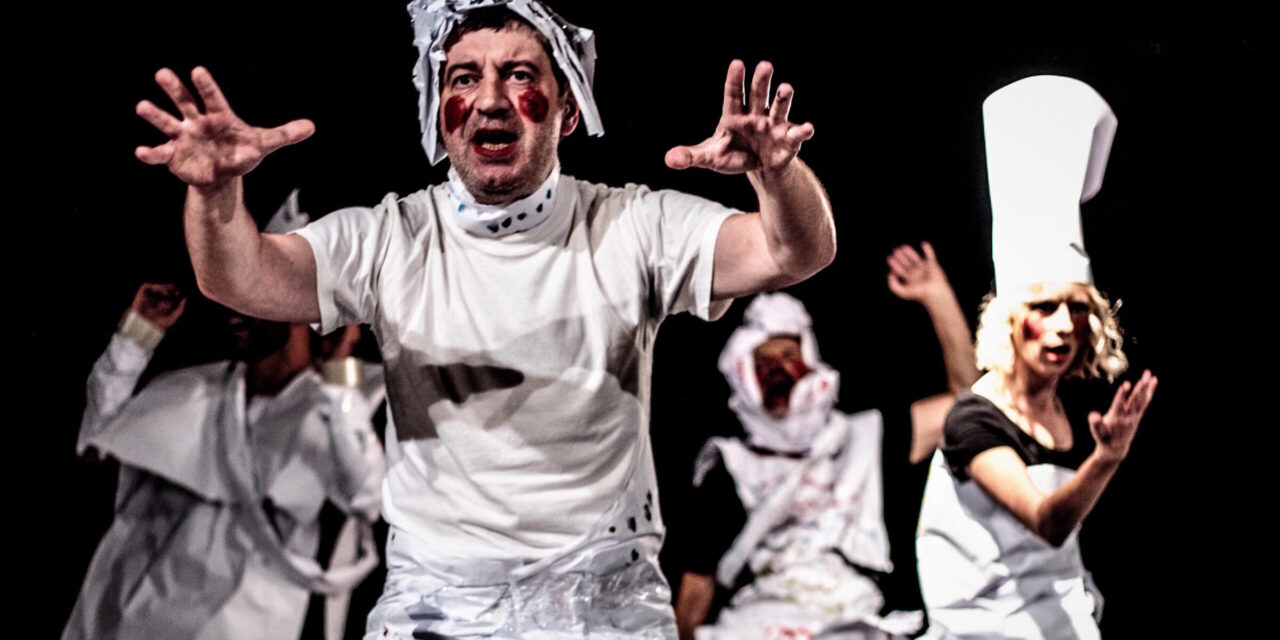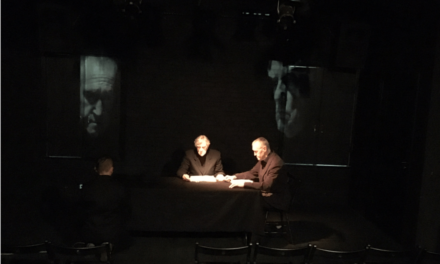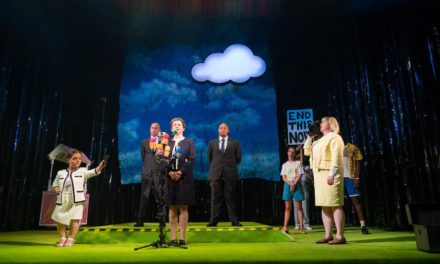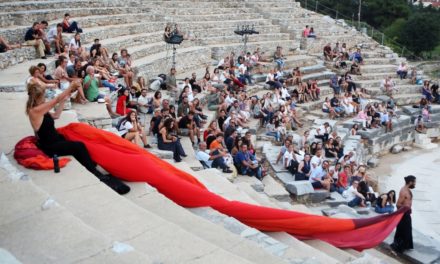The Jerzy Szaniawski Dramatic Theater in Wałbrzych opens the season with a play built on one of the most basic building blocks of theater ‒ language. Visually, Lady of Pestilence (PaniMoru) is conspicuously sparse. To greet the new world emerging out of a disaster, Sebastian Majewski has penned a brusque, dissonant, and chafing fairy tale that holds up a broken mirror to the world.
When the pandemic hit, Szaniawski found his own way of responding to it; it was one very much unlike uploading a series of recorded shows to the Internet. This, of course, does not mean that he had no online presence, which seems an absolute must these days. As part of a project called Szaniawski in Slippers (Szaniawski w kapciach), his actors streamed from their homes, some of them delivering self-authored World Theater Day messages. Reviewers and directors, on the other hand, discussed eagerly awaited productions that had failed to materialize due to the pandemic. What these efforts had in common was a focus on maintaining links with audiences and reminding them that, lockdown or not, theaters were still working, albeit in a limited fashion. When preparing for the premiere of Lady of Pestilence, Szaniawski posted a series of conversations with directors whose work was interrupted by the pandemic and with managers of other Wałbrzych-based arts outfits. Meanwhile, the actors fielded questions from theater critics, those who were to tread the boards of Wałbrzych theaters in the new season spoke about their hopes, while everyone involved in the project recorded the sounds of the pandemic in their homes, gardens, in the woods and meadows. These preparations and Szaniawski’s earlier project, the online play Field 150 sq.m. (Pole 150 mkw), which opened in May and included his actors’ pandemic-era monologues, could lead to the expectation of another self-referential story. Is Lady of Pestilence such a tale? If it is, its self-referential aspect is not straightforward. What is more, theatrical self-referentiality is just one part of the story.
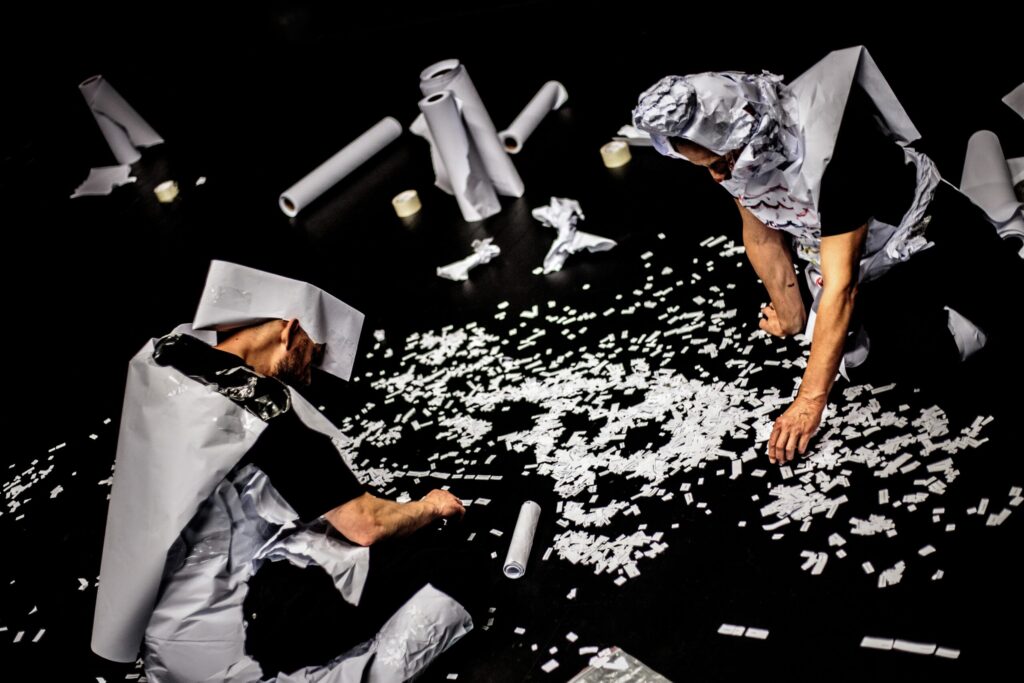
Czesław Skwarek and Ryszard Węgrzyn in Pani Moru. (Lady of Pestilence) Written and directed by Sebastian Majewski. Photo by Tobiasz Papuczys.
Arguably, the creators did not intend to enchant audiences with anything other than words and the actors’ interpretation of them. The lights are purely technical, illuminating the entire stage without splitting it into sections, and the actors can see us‒ masked, spaced out around the auditorium ‒ as clearly as we can see them. This deliberate oddity is reflected in what is seen from the stage ‒ only half the seats are occupied, and this was the case even during the first performance. On top of that, the actors can hardly read the emotions on the masked faces of the audience. Even the applause is muted as if the empty spaces between audience members disrupted the flow of energy. Something’s happened; the world, including the theater, has slipped out of its frame ‒ this is clear for everyone on stage and in the audience.
The process of getting into make-up and costume has been moved to the back of the stage ‒ the actors tear and cut white paper into pieces and tape them together into costumes, and they paint their cheeks red to signal health or fever. Before our eyes, they turn into Harlequins and Colombines in a semi-throwback to commedia dell’arte, but they are somehow imperfect, underdressed, and under-made-up. The impression of austerity is heightened by the absence of music; the only exception being a snippet of a minuet sung a capella by the actors. One element evading the rule of ostensible improvisation in the “DIY theater” mode is the “screen” suspended above the stage on which scraps of paper are arranged into words. This is a window leading outward, outside the performance space, where the combinations of words form a dry, headline-worthy chronicle of the pandemic, including its impact on theatre: First Infection in Wuhan, First Theories of Virus Origin, Social Isolation Begins in Poland, Weronika Szczawińska’s World Theater Day Message, Vaccine Research Funding, Polish Government’s Emergency Measures, Edyta Górniak’s Theories. But before the performance really gets off the ground, the key message of its form is “this is the future of theater, get ready for it.” We will have to tighten our belt and ‒ for the sake of survival ‒ shed the ornaments. Instead, we rely on fundamentals, the very essence of art, without which it would have no raison d’être. Paring things down is the order of the day.
So much for form, but what about content? The play is set in a kingdom ruled by a royal couple (Irena Sierakowska and Piotr Mokrzycki), where life is so good that you can let go of all worries, including concerns about the world’s future, and dedicate yourself to coining new words. One day this exercise proves to be dangerous, though. The words take on a life of their own and chaos descends on the kingdom. This is what happens to the word “virus,” which emerges our of the royal alchemist’s (Ryszard Węgrzyn) alembics and, once released, conjures other perilous notions such as “infection,” “outbreak,” “pandemic,” “soap,” “mask,” “regime,” “the web,” “zoom,” “online.” This glossary of the pandemic must be expanded to include new definitions: “remote work,” which designates a new slavery, “shield”‒ a new currency, “mail”‒ ballot boxes, and “flattening,” referring to a new branch of mechanics. And there are also creepy words such as “hoi polloi” and “social exclusion.” The thing is that the term “democracy,” which had been vitally important until very recently, has just ceased to exist, so there is nothing to fall back on.
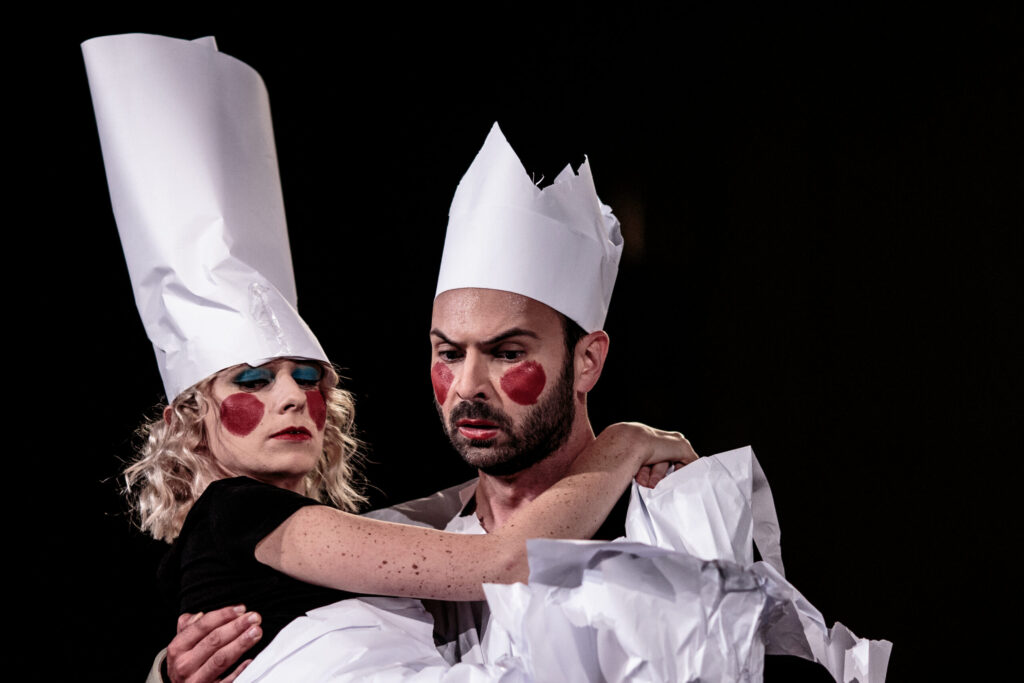
Irena Sierakowska and Piotr Mokrzycki in Pani Moru. (Lady of Pestilence) Written and directed by Sebastian Majewski. Photo by Tobiasz Papuczys.
The words multiply like viruses and their pandemic will soon be ubiquitous. The trouble is that the kingdom has no doctors (or everybody ignores them), so the President of the Web (Michał Kosela) is elevated to be the sole authority on the nation’s health. He gives a host of contradictory diagnoses, each of which gains an instant following. While conspiracy theories abound, the theater stage, where artists would be able to say something sensible about the virus, is shut down, covered with soil and sown with seed. Given all this, a disaster seems imminent.
Lady of Pestilence (the theatre’s stage manager Anna Solarek) utters only a few dozen words in the show. Most of the time she saunters around the stage in silence or paints decorations on the characters’ paper outfits. She doesn’t speak until the finale when she declares that she never arrives uninvited. Who’s invited her? In Majewski’s production, it is society itself that leaves the door ajar to the epidemic. Its members are lazy, indolent, desensitized by comfortable living and indifferent to the world’s crises. When everything people need is provided, nobody worries about the problems of mis-sold Swiss franc mortgages, the quality of democracy, or the deteriorating climate. Idleness cracks open the door to galloping stupidity, making us susceptible to conspiracy theories. We start to believe that the virus, the crazy “Miley Cyrus,” is a big scam engineered to enable Bill Gates to enslave us with mind-control chips injected with the vaccine, and some people (quite a few, actually) react aggressively when asked to mask up in public. The pandemic has undermined the world as we know it, but we prefer to hang on to it tightly rather than make an effort to steer our minds onto new paths.
Majewski’s use of the fairytale genre has significant ramifications for the dramaturgy of the show. The characters not so much play their respective parts but form a choir of storytellers, with soloists emerging from time to time. They are all there: the King, the Queen, the Alchemist, the Jester, the Multimillionaire, and the President of the Web, but monologues are rare. Rather, the characters juggle the narrative between each other, bouncing it off one another like a tennis ball. The actors do not engage in interactions to reveal the feelings and emotions of their characters but recount the successive chapters of a fairy tale. This creates detachment, which is only intensified by the dominant third-person narrative. The fairytale characters and the visual form of “imperfect” commedia dell’arte places the story in “quotation marks,” automatically turning it, as it were, into a metaphor. Given the duration of the show (a mere hour), the metaphor is surprisingly capacious as Lady of Pestilence is a reflection of a whole spectrum of aspects of the pandemic: the political entanglement of the battle against the virus, the deepening of social divisions due to the pandemic, and the notion of post-truth, which predates the epidemic but has been injected new life in recent months. Lady of Pestilence is a parable about manipulation of power and a lost society, and a theater that must be laboriously rebuilt from scratch. A challenging, dissonant fairy tale, the play may not leave you euphoric but will linger in your mind for a long while, nagging like a pebble in your shoe.
Teatr Dramatyczny im. Jerzego Szaniawskiego, Wałbrzych
Lady of Pestilence (Pani Moru). Written and directed by Sebastian Majewski, choreography by Wojciech Marek Kozak.
Premiered on September 4th, 2020
This article was originally published in Polish by Didaskalia. Theater Journal 2020, no. 159. It was translated into English by Didaskalia and TheTheatreTimes.com and reposted with permission. The translation was supported by Polonia Aid Foundation Trust.
Didaskalia is now an open-access journal. The frequency remains unchanged and they will continue to appear bimonthly.
This post was written by the author in their personal capacity.The opinions expressed in this article are the author’s own and do not reflect the view of The Theatre Times, their staff or collaborators.
This post was written by Magda Piekarska.
The views expressed here belong to the author and do not necessarily reflect our views and opinions.

